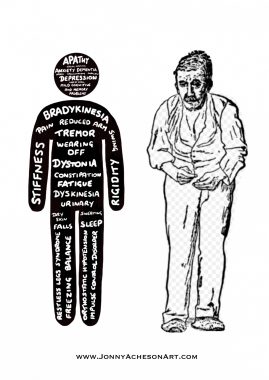Visualizing Parkinson’s: A Conversation With Artist Jonny Acheson, MD

I recalled the popular adage that “a picture is worth a thousand words” when a Parkinson Secrets blog post appeared on my Twitter feed. Titled “How LEGO became a tool to teach Parkinson’s: A father and daughter journey,” the post includes an interview with Dr. Jonny Acheson, who serves as the blog’s artist and co-author.
Acheson, a doctor of emergency medicine at University Hospitals of Leicester in the U.K., was diagnosed with Parkinson’s disease in 2016. When his daughter pointed out the similarities between Lego figures and people with Parkinson’s, Acheson started to sketch Lego people with Parkinson’s symptoms.
When I saw the images included in the blog post, I thought they were genius. At times, I feel like a Lego girl, and this reminded me that I’m not alone.

(Courtesy of Jonny Acheson Art)
To learn more about Acheson and his art, I reached out and spoke with him via email and Zoom. I found him to be an inspiration. Following are excerpts of our conversations, with light editing for clarity.
LD: How did you get started in Parkinson’s art?
JA: I always drew as a child and a little bit through medical school, but I found when I started working in the hospital, the long hours meant I didn’t have time anymore. However, two years after being diagnosed with Parkinson’s, I lifted up my pencil and sketch pad again.
Initially, I drew the story of the diagnosis through the eyes of my daughter, which was, in hindsight, a coping mechanism. Following that, I decided to draw some educational art around the symptoms of Parkinson’s, both the motor and nonmotor, and some medication side effects. To do this, I took the letters in the word of a particular symptom and attempted to draw a cartoon around it portraying what it might feel like for someone who doesn’t experience what it feels like to live every day with Parkinson’s.
How do you think art is beneficial for people with Parkinson’s?
Art has been very beneficial for me in my Parkinson’s journey. It has given me an outlet that is not only creative, but also educational. I find it relaxing. It helps focus my mind, and I am able to concentrate better and for longer periods of time.
In my mind I was most creative when I was on a higher dose of a dopamine agonist. The ideas just flowed. I would draw one sketch, and the idea for the next one was there. I completed the 32 Parkinson’s Portrayed Symptoms collection in about four months. I sold them for Parkinson’s charities, but now they are available to be downloaded for free from my website.
I also drew satirical emergency medicine cartoons and produced the Royal College of Emergency Medicine’s calendar in 2019 and 2020. However, over time I realized that drawing about Parkinson’s and emergency medicine while living with one and working with another wasn’t healthy.
Now, I am on a lower dose of an agonist. The ideas still flow, but in more of a normal way. I now draw mainly for enjoyment, including the blog artwork for [Parkinson Secrets blog co-authors] Dr. Michael Okun and Dr. Indu Subramanian, pet art, and child animal art.
My symptoms initially were left-sided and didn’t impact my art at all, as I am right-handed. However, recently, I have noticed that the lines are not as straight or as smooth when I am wearing off. Therefore, I draw when I know I will be on.
What is your favorite piece?
My favorite piece is the gender-neutral, race-neutral, and educational symptom figure. It incorporates both the motor and the invisible nonmotor symptoms together with medication side effects. I like it because not only does it offer an alternative to the [1886] image of an older man hunched over with advanced Parkinson’s, it is an image that everyone with Parkinson’s can relate to when they look at it. They just might see something of themselves in it.

Jonny Acheson’s Parkinson’s figure, left, and Sir William Richard Gowers’ 1886 Parkinson’s figure, right. (Courtesy of Jonny Acheson Art)
Another favorite piece is similar to the symptom figure [and] was published in the latest MDT book [“Parkinson’s Disease: A Multidisciplinary Guide to Management”] about Parkinson’s care. It incorporates management strategies to live well with Parkinson’s as much as you can every day.
***
While these drawings are Acheson’s favorite pieces, two of his videos are the work that tugged the hardest on my heartstrings. He uses a series of simple pictures to create a story he never intended to tell — the story of his Parkinson’s through the eyes of his children. The videos, which may be viewed here and here, are heartwarming and educational for all ages, but especially for the children in our lives.
I encourage you to view more of Acheson’s art at his website and share it to promote Parkinson’s awareness.
Note: Parkinson’s News Today is strictly a news and information website about the disease. It does not provide medical advice, diagnosis, or treatment. This content is not intended to be a substitute for professional medical advice, diagnosis, or treatment. Always seek the advice of your physician or another qualified health provider with any questions you may have regarding a medical condition. Never disregard professional medical advice or delay in seeking it because of something you have read on this website. The opinions expressed in this column are not those of Parkinson’s News Today or its parent company, BioNews, and are intended to spark discussion about issues pertaining to Parkinson’s disease.








Comments